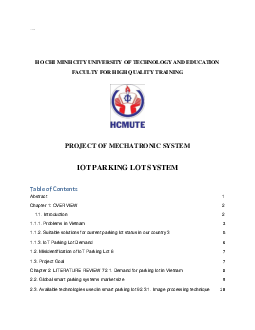


Preview text:
lOMoAR cPSD| 58728417
Internet of Things (IoT) in Mechatronic Systems 1. Introduction
The rapid advancement of technology in the 21st century has led to the convergence of various
engineering domains, giving rise to smart and interconnected systems. Mechatronics, which
combines mechanical engineering, electronics, control systems, and computer science, plays a
crucial role in modern automation and robotics. When integrated with the Internet of Things (IoT),
mechatronic systems become more intelligent, responsive, and efficient.
The Internet of Things refers to the global network of physical devices embedded with sensors,
software, and connectivity, allowing them to collect and exchange data. When applied to
mechatronic systems, IoT enables real-time monitoring, remote control, predictive maintenance,
and data-driven decision-making.
This paper explores the integration of IoT in mechatronic systems, highlighting the benefits,
applications, challenges, and future trends of this powerful technological synergy.
2. Fundamentals of Mechatronic Systems and IoT 2.1 Mechatronic Systems
Mechatronic systems are engineered systems that synergistically integrate mechanical
components, electronic hardware, control theory, and computing. These systems are designed to
perform complex tasks with high precision and automation. Examples include:
- CNC (Computer Numerical Control) machines - Autonomous robots
- Anti-lock braking systems (ABS) in vehicles - Smart appliances - Automated conveyor systems 2.2 Internet of Things (IoT)
The Internet of Things is a technological paradigm where everyday objects are embedded with
electronics, sensors, and connectivity, allowing them to send and receive data via the internet.
Key components of IoT include: - Sensors - Actuators - Microcontrollers - Connectivity modules - Cloud platforms lOMoAR cPSD| 58728417
The integration of IoT into mechatronic systems allows for enhanced control, optimization, and automation.
3. Applications of IoT in Mechatronic Systems
3.1 Smart Manufacturing (Industry 4.0)
IoT-enabled mechatronic systems are foundational in Industry 4.0. Machines can monitor their
own health, communicate with each other, and adapt to changing production needs. 3.2 Smart Agriculture
Automated irrigation systems and drones use IoT-connected mechatronic devices to monitor soil
moisture, weather conditions, and crop health.
3.3 Healthcare and Assistive Devices
IoT in smart prosthetics allows devices to adapt to user movements and even connect to mobile apps for calibration.
3.4 Home and Building Automation
Mechatronic systems like automated blinds, HVAC systems, and security doors become smarter with IoT integration.
4. Benefits of IoT-Integrated Mechatronic Systems - Remote Monitoring - Predictive Maintenance - Energy Efficiency - Data-Driven Decision Making - User Customization
This integration results in systems that are not only more efficient but also safer and more reliable.
5. Challenges and Considerations - Cybersecurity - Interoperability
- Latency and Real-Time Constraints - Power Consumption - Scalability
Addressing these challenges is essential to fully harness the potential of IoT-enabled mechatronic systems. 6. Future Trends - Edge Computing lOMoAR cPSD| 58728417
- Artificial Intelligence (AI) - Digital Twins - 5G Networks - Standardization
These advancements will make future mechatronic systems even more autonomous, intelligent, and interconnected. 7. Conclusion
The integration of Internet of Things (IoT) into mechatronic systems is transforming the way
machines operate, communicate, and interact with their environment. From industrial
automation to healthcare and agriculture, IoT-enabled mechatronic systems provide improved
performance, adaptability, and efficiency.
While there are challenges to address, the benefits and future potential far outweigh the
limitations. As technologies continue to evolve, the fusion of IoT and mechatronics will drive
innovation and enable smarter, more sustainable systems for the future.
